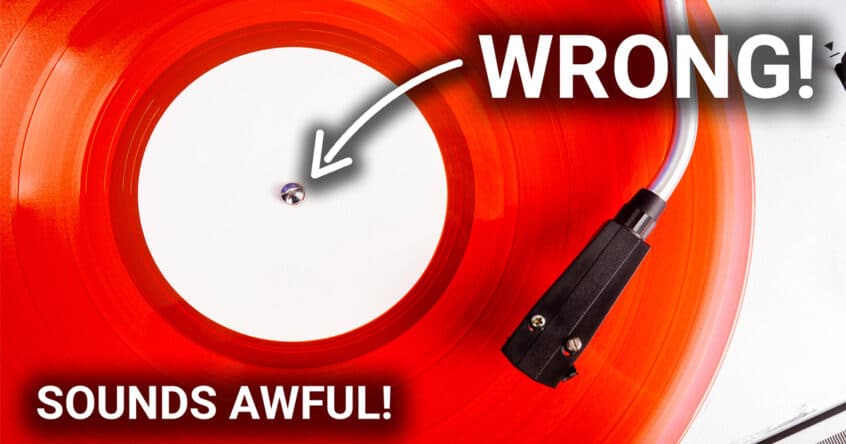Off-center records are all too common and sometimes tricky to spot. It’s a vinyl pressing error and there’s a good chance you’ve got some off-center records lurking in your collection.
Below, we explain what an off-center record is, how to spot one visually, and how it affects sound quality.
Lastly, we’ll explain what you can do to correct the problem.
What Is Off Center Pressing?
A record pressed off-center – meaning the spindle hole is not central to the grooves stamped on the vinyl – is a glaring pressing error that will result in small speed discrepancies as the disc spins, causing audible wow and flutter pitch drift.
How do I know if my vinyl is off-center?
If your tonearm is wobbling from side-to-side instead of staying still when tracking the groove, this is a tell-tale sign that your record spindle hole is punched off-center.
What Does an Off-Center Record Sound Like?
When a record is pressed off-center, the stylus can’t track the groove accurately. The most obvious side-effect is pitch variation as the record rotates.
This is what we call “wow” as part of wow and flutter pitch irregularities.
You’ll hear these pitch variations loud and clear on longer, more drawn-out notes or chords. It’s almost like you’re rocking from side-to-side as you listen.
Some listeners also report hearing a “lack of focus” in the sound or a feeling of excess reverb (an almost washy, underwater sound, if you like).
In short, if your tonearm is moving relative to the groove, then this will degrade the audio performance.
Depending on how far off-center your record is, the audibility of the problem can range from very mild (almost unnoticeable) to extreme (immediately audible to any listener, audiophile, or otherwise).
How Do You Fix an Off-Center Vinyl Record?
The only way to “fix” an off-center record is to crudely widen the spindle hole with a knife or file. After this, you can manually center the record each time you play it. A record clamp will help you secure the disc in place. To say this is less than ideal would be an understatement.
vinylcare.com offer some additional advice on how you can carefully perform this procedure more accurately to avoid excessively widening the spindle hole. For me, though, this is further than I’m willing to go as a collector.
If a record is off-center, my vote is to simply return it and look for another copy.
Sadly, if a record pressing is off-center, it usually means the entire batch is affected; you’ll need to look for another run of that particular record to avoid yet another copy with exactly the same problem.
How common are off-center pressings in your collection? What needs to be done to ensure this issue is avoided during the manufacturing process? Let us know your thoughts in the comments below.




Hello, Ds audio makes an eccentricity unit to correct for such the cost is $6000us,read the review at analogplanet
The Steve Wilson clear vinyl remix RSD issue of Roxy Music’s first album had a batch which was wildly off centre and unlistenable. Also The Jackson 5 Greatest Hits Quadrophonic mix on clear vinyl had the same problem. I was lucky enough to find a perfect copy of both.
I have seen some records that are so wildly off that you wonder if the person at the record plant was drunk! Haha
One of my favorite LPs was Joe Walsh’s Barnstorm, with the original version of Turn To Stone, the FM “non-hit”…
I bought a number of copies of this one, only to find out that the last “few” were actually getting “better”…
Having owned a record manufacturing facility in Marietta, Georgia back in the early 70s, it’s definitely a manufacturing issue, probably in the plating step. That’s where the stamper is centered, trimmed and formed. It’s hard to mess up a properly centered stamper, but possible, if not properly affixed to the die.
Our plant did it all (mastering/plating/pressing/label printing/jacket printing/fabrication/shrinkwrap) so, if there was any problem with manufacturing…it was on us. Of course, we could only do so much with the master, though we tried. This link should take you to some photos on my FB page. Kayward Davis
https://www.facebook.com/media/set/?set=a.430297013623&type=3